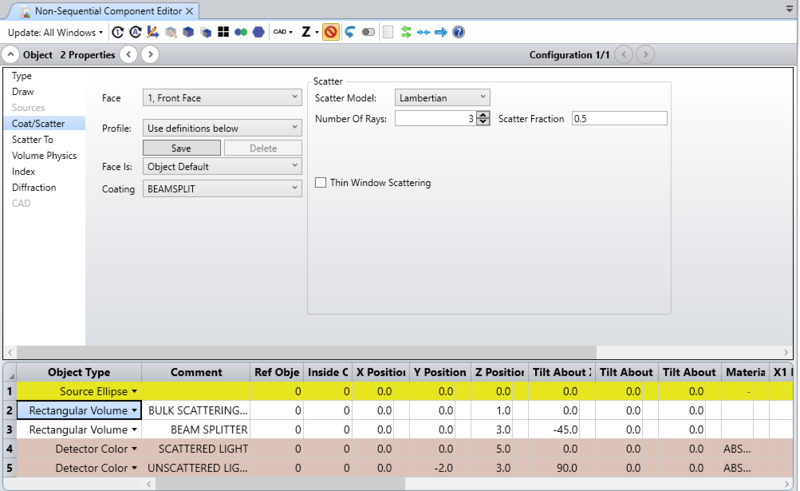Coat/Scatter
Object coating and scattering options are set in the Coat/Scatter section of the Object Properties window. The Object Properties can be reached by clicking the down arrow in the Object Properties bar above the NSC Editor.

The Coat/Scatter section supports the following controls:
Face The face to which the properties will be applied. For imported CAD objects, see the " CAD " section of the Object Properties. A face is a collection of one or more surfaces on an object upon which the same optical properties are applied. For example, for a singlet lens, there are 3 faces: the front face, the back face, and all remaining faces (which include the edges and squared faces around the edges). In this case, 3 different coatings may be applied; one to each face group, if all faces of the lens are coated. Note that more than one surface may be grouped together in a single face number, and all surfaces in the same face group have the same optical properties. The valid face numbers are 0 through 50, although most objects have less than 4 faces.
Profile A profile is a collection of settings related to the thin film coatings and scattering model data applied to an object face. Suppose that many objects in an optical system are all composed of the same material and have the same coating and scattering properties. Rather than type this identical data in for each object and face; the data may be typed in once, then saved to a profile. Once saved, any other object face may use the same profile. Profiles are stored in the file whose name is specified on the Files section of the System Explorer; see "Scatter Profile" for details. If unique settings for this object are desired, then choose "Use definitions below" to edit the scattering parameters. If a profile is selected; then the coating and scattering data boxes will be disabled, as this data is defined by the selected profile. However, the settings will be displayed.
Save Saves the current scattering settings as a new profile. Pressing this button will prompt for the name of the new profile.
Delete Removes the currently selected profile from the Scatter Profile file.
Face Is This setting controls whether the face is refractive, reflective, or absorbing. The following options are available:
-
"Object Default" means the face is either refractive, reflective, or absorbing, depending upon the material type defined in the NSC Editor.
-
"Reflective" means the face is always reflective. The transmitted part of the light is ignored. "Reflective" assumes the surface is coated with a thick layer of aluminum, with an index of refraction of 0.7-7.0i (at 0.55um). The layer is assumed to be thick enough that no light propagates past the layer.
-
"Absorbing" means the face is always absorbing.
Coating The name of the coating to apply to the surfaces with the selected face number. Coatings are defined in the system coating file. For more information, see Defining Coatings.
Polarization and thin film coatings
Rays traced through non-sequential components may be done while accounting for polarization effects, or polarization may be ignored. The initial polarization state for a ray is determined by the source properties, see the "Sources" section of the Object Properties. If polarization ray tracing is being used, transmission, reflection, and absorption of optical energy is accounted for at all surfaces. Bulk absorption is also accounted for. Thin film coatings significantly affect transmission and reflection properties of optical surfaces. Surfaces are initially uncoated, but coatings may be applied to surfaces or group of surfaces.
Coatings on surfaces in contact
If two surfaces are in contact, such as two 45-45-90 prisms placed so that one face of each prism is in contact with the other, then a coating may be applied "between" the surfaces in contact.
This is accomplished using the same convention described above in the section "Object Placement". The rule is: the LAST object listed in the NSC Editor determines the properties of the interface between two objects.
For example, to place a thin metal coating on the interface between two prisms arranged to form a beam splitter, the first prism object listed should have the contact surface "uncoated", while the second object listed should have the contact surface coated with the appropriate thin film coating. Rays striking this interface from either side will see the correct coating, and the ray transmission and/or reflection will be correctly computed. Note prisms modeled as POB objects can have different coatings applied to different faces, so some faces may be anti-reflection coated while others are coated with a reflective coating.
Next:


